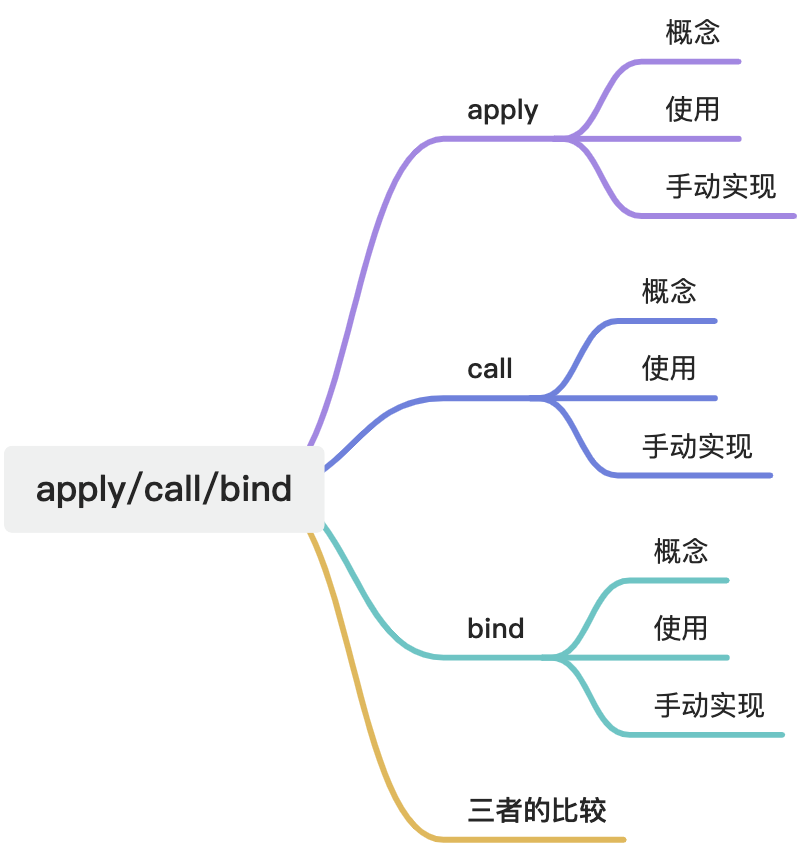apply、call、bind 比较

apply
概念
apply() 方法调用一个具有给定this值的函数,以及以一个数组(或一个类数组对象)的形式提供的参数。
func.apply(thisArg);
func.apply(thisArg, argsArray);thisArg
在 func 函数运行时使用的 this 值。请注意,this 可能不是该方法看到的实际值:如果这个函数处于非严格模式下,则指定为 null 或 undefined 时会自动替换为指向全局对象,原始值会被包装。
argsArray (可选)
一个数组或者类数组对象,其中的数组元素将作为单独的参数传给 func 函数。如果该参数的值为 null 或 undefined,则表示不需要传入任何参数。从 ECMAScript 5 开始可以使用类数组对象。浏览器兼容性请参阅本文底部内容。
返回值
调用有指定 this 值和参数的函数的结果。
使用
- 改变函数内
this的指向
const person = {
name: "John",
greet() {
console.log(`Hello, my name is ${this.name}`);
},
};
const greetFunc = person.greet;
greetFunc(); // Hello, my name is undefined
greetFunc.apply(person); // Hello, my name is John- 将数组作为参数传递给函数
function sum(x, y, z) {
return x + y + z;
}
const numbers = [1, 2, 3];
sum.apply(null, numbers); // 6- 结合函数的剩余参数使用
const numbers = [1, 2, 3, 4, 5];
Math.max(...numbers); // 5
Math.max.apply(null, numbers); // 5- 绑定回调函数的
this指向
const handler = {
message: "Hello World",
printMessage() {
console.log(this.message);
},
};
document.body.addEventListener("click", handler.printMessage); // Unable to print message
document.body.addEventListener("click", handler.printMessage.bind(handler)); // Bind this
document.body.addEventListener(
"click",
handler.printMessage.apply.bind(handler.printMessage, handler)
); // Apply bind手动实现
🏅 关键点:apply 的两个参数是函数运行的上下文 this 和参数数组
Function.prototype.myApply = function (context, args) {
// 判断
if (typeof this !== "function") {
throw new TypeError("Error");
}
// 唯一key/防止context对象有key/不能随便定义
const symbolKey = Symbol();
// 处理边界情况
context = context || window;
context[symbolKey] = this;
const result = args ? context[symbolKey](...args) : context[symbolKey]();
// 执行完借用的函数后,删除掉
delete context[symbolKey];
return result;
};call
概念
call() 方法使用一个指定的this值和单独给出的一个或多个参数来调用一个函数。
func.call(thisArg, arg1, arg2, ...)thisArg
可选的。在 func 函数运行时使用的this值。请注意,this 可能不是该方法看到的实际值:如果这个函数处于非严格模式下,则指定为 null 或 undefined 时会自动替换为指向全局对象,原始值会被包装。
arg1, arg2, ...
指定的参数列表。
返回值
使用调用者提供的 this 值和参数调用该函数的返回值。若该方法没有返回值,则返回 undefined。
使用
在 JavaScript 中,call()方法和apply()方法很相似,也有一些常见的使用场景:
- 改变函数内
this的指向
const person = {
name: "John",
greet() {
console.log(`Hello, my name is ${this.name}`);
},
};
const greetFunc = person.greet;
greetFunc(); // Hello, my name is undefined
greetFunc.call(person); // Hello, my name is John- 借用其他对象的方法
const person1 = {
name: "John",
greet() {
console.log(`Hello, my name is ${this.name}`);
},
};
const person2 = {
name: "Sarah",
};
person1.greet.call(person2); // Hello, my name is Sarah这里 person2 借用了 person1 的greet方法。
- 应用函数,指定参数
function greet(lang) {
if (lang === "en") {
console.log("Hello World");
} else if (lang === "fr") {
console.log("Bonjour le monde");
}
}
greet.call(null, "fr"); // Bonjour le mondecall()允许直接传递函数参数。
- 结合函数的剩余参数使用
function sum(...numbers) {
return numbers.reduce((total, n) => total + n, 0);
}
const nums = [1, 2, 3, 4, 5];
sum.call(null, ...nums); // 15手动实现
🏅 关键点:call 接收多个参数,第一个为上下文 this,后面为函数参数
Function.prototype.myCall = function (context, ...args) {
// 判断
if (typeof this !== "function") {
throw new TypeError("Error");
}
// 唯一key/防止context对象有key/不能随便定义
const symbolKey = Symbol();
// 处理边界情况
context = context || window;
context[symbolKey] = this;
const result = args ? context[symbolKey](...args) : context[symbolKey]();
// 执行完借用的函数后
delete context[symbolKey];
return result;
};bind
概念
bind() 方法创建一个新的函数,在 bind() 被调用时,这个新函数的 this 被指定为 bind() 的第一个参数,而其余参数将作为新函数的参数,供调用时使用。
thisArg
调用绑定函数时作为 this 参数传递给目标函数的值。如果使用new运算符构造绑定函数,则忽略该值。当使用 bind 在 setTimeout 中创建一个函数(作为回调提供)时,作为 thisArg 传递的任何原始值都将转换为 object。如果 bind 函数的参数列表为空,或者thisArg是null或undefined,执行作用域的 this 将被视为新函数的 thisArg。
arg1, arg2, ...
当目标函数被调用时,被预置入绑定函数的参数列表中的参数。
返回值
返回一个原函数的拷贝,并拥有指定的 this 值和初始参数。
使用
- 保存函数上下文
在回调函数中使用bind来绑定this,以免丢失函数上下文。
function log() {
console.log(this.name);
}
const obj = { name: "Jack" };
setTimeout(log.bind(obj), 1000);- 部分应用函数
通过bind()可以绑定函数的部分参数,返回一个新的函数。
function mul(a, b) {
return a * b;
}
const double = mul.bind(null, 2);
double(3); // 6
double(4); // 8- 创建高阶函数
bind()允许你通过给一个函数绑定作用域来定制它的行为。
function greet(prefix, name) {
console.log(prefix + " " + name);
}
const greetHello = greet.bind(null, "Hello");
greetHello("John"); // Hello John- 箭头函数没有
this,可以通过bind()来获取外层this
const person = {
name: "Jack",
sayName: () => {
console.log(this.name); // undefined
setTimeout(() => {
console.log(this.name); // undefined
}, 100);
},
};
person.sayName();
// 解决方案
const person = {
name: "Jack",
sayName: function () {
console.log(this.name);
setTimeout(
function () {
console.log(this.name);
}.bind(this),
100
);
},
};
person.sayName();手动实现
🏅 关键点:bind 不会立即执行函数,需要返回一个改变了上下文的函数
Function.prototype.myBind = function (context, ...bindArgs) {
if (typeof this !== "function") {
throw new TypeError("Error");
}
// 处理边界条件
context = context || {};
const symbolKey = Symbol();
target[symbolKey] = this;
return function (...innerArgs) {
// 返回一个函数
// bindArgs和innerArgs都是一个数组,解构后传入函数
const res = context[symbolKey](...bindArgs, ...innerArgs);
// 这里千万不能销毁绑定的函数,否则第二次调用的时候,就会出现问题
return res;
};
};三者的比较
apply、call 和 bind 这三个方法都可以改变函数内部的 this 指向,但有以下区别:
- 传参方式不同
apply接收两个参数,第一个是指定的this值,第二个是数组或类数组对象。call接收多个参数,第一个是指定的this值,后面的是函数的参数。bind传参方式和 call 一样,只是它返回一个绑定了this的函数。
- 是否立即执行函数
apply和call会立即执行函数。bind不会立即执行,而是返回一个改变了this指向的函数。
- 是否返回结果
apply和call会立即执行,所以会有返回结果。bind只是绑定this,不会执行,所以不会有返回结果,调用绑定后的函数才会返回结果。
- 独有功能
apply可以把数组作为函数的参数。bind可以绑定函数的this和部分参数,返回绑定后的函数。
所以主要区别是:
call和apply立即执行,bind返回绑定后的函数call和bind接收参数列表,apply 接收数组bind可以绑定this和部分参数
彩蛋 🤩
- 利用 apply 来实现 call
Function.prototype.myCall = function (context, ...args) {
context = context || window;
// 使用 apply 来调用函数
args = args ? [...args] : [];
return this.apply(context, args);
};- 利用 call 实现 apply
Function.prototype.myApply = function (context, args) {
// 判断 args 是否为数组
if (!Array.isArray(args)) {
throw new TypeError("Second argument must be an array");
}
// 展开数组为参数
args = [...args];
// 使用 call 实现 apply
return this.call(context, ...args);
};- 利用 apply 实现 bind
Function.prototype.myBind = function (context, ...bindArgs) {
const fn = this;
return function (...callArgs) {
// 合并 bind 参数和调用参数
const args = [...bindArgs, ...callArgs];
// 使用 apply 改变 this 指向并传入参数
return fn.apply(context, args);
};
};